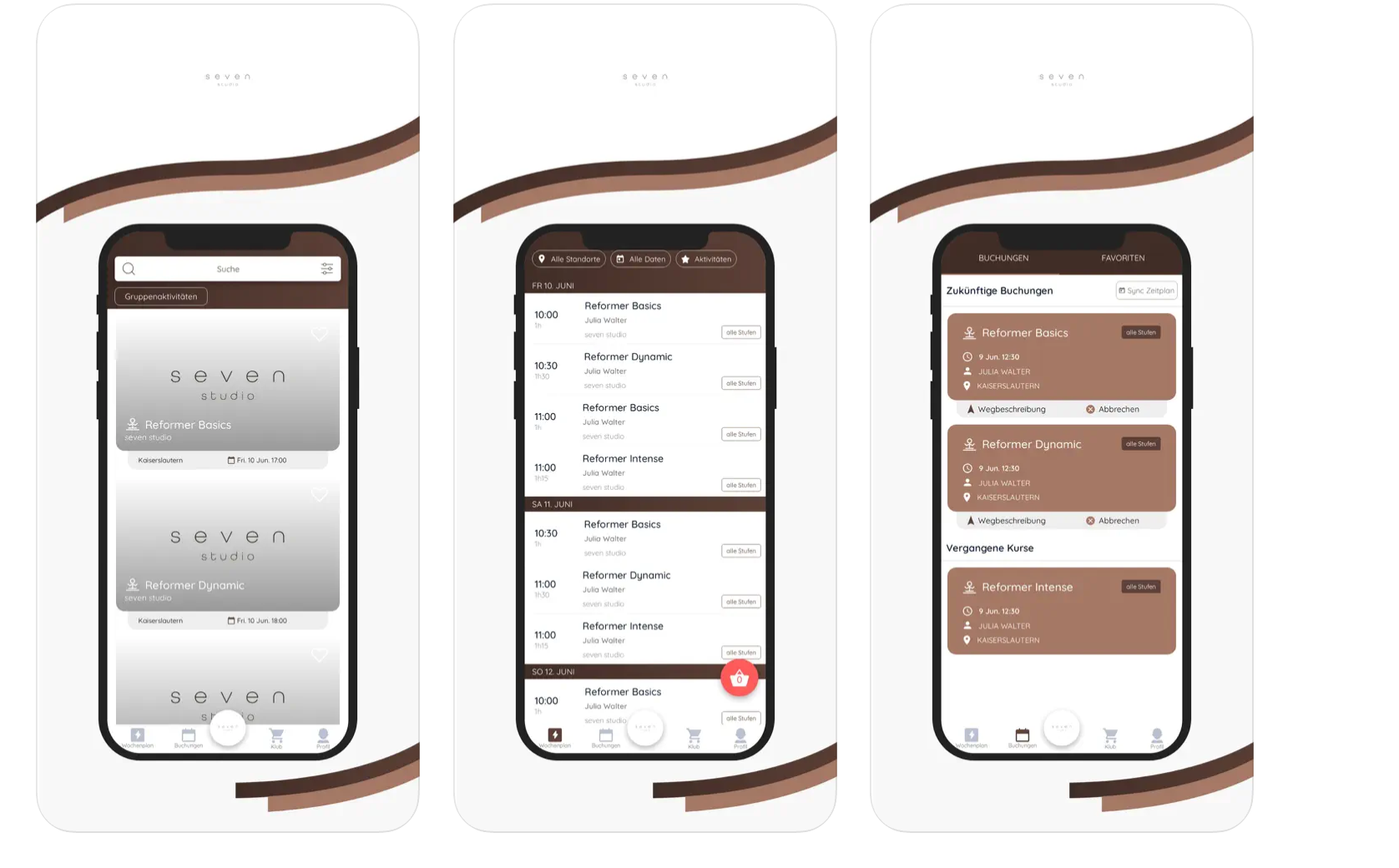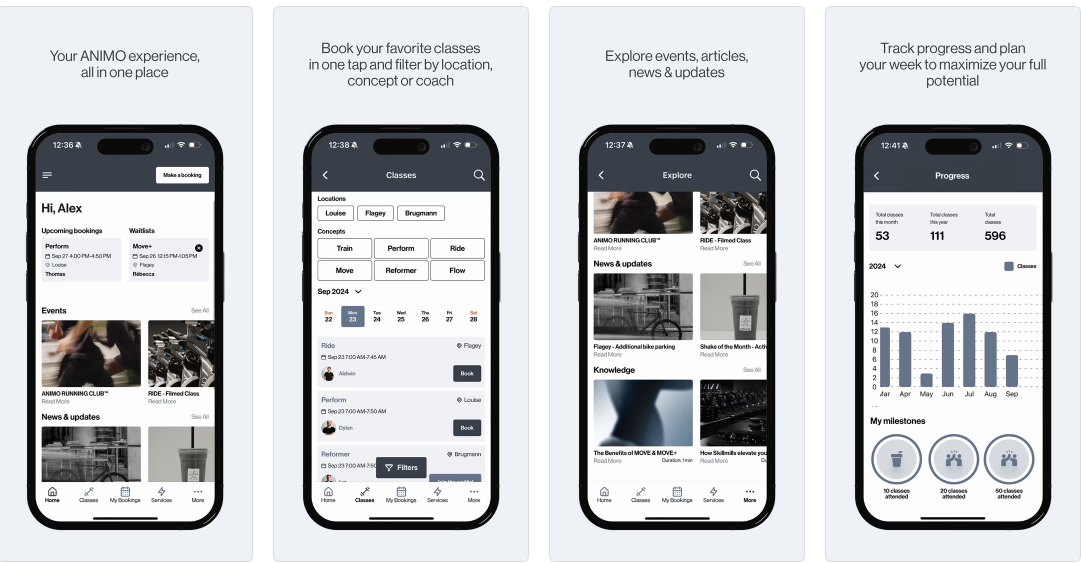If you're running a gym or studio, sooner or later you'll need a gym management system (GMS) or a mobile app - or both. And the default question becomes:
Should we build our system or buy something off the shelf?
Most gyms start by choosing an off-the-shelf platform like bsport, Mindbody, or Xplor - and for good reason:
- You get class scheduling, payment processing, payroll, and notifications
- The system is ready to go, with minimal configuration
- No development team or technical maintenance required
This setup works well for small, class-based studios. But eventually - especially if you're growing or aiming to stand out — those built-in features start feeling like constraints.
That’s exactly what happened with our client, Lumino Studios (name changed for confidentiality, results are real) - a premium fitness and wellness brand expanding across Europe.
When the Off-The-Shelf Platform For Gym Becomes the Problem
Lumino tried various platforms until they signed with bsport. It worked — until it didn’t.
Here’s what changed:
- They opened larger, multi-zone locations with the ability to book personal training sessions, or schedule massage‑and‑recovery treatments - and bsport didn’t support open access control (as they promised)
- The Lumino's team wanted to show user progress, coach reviews, and class ratings - but the API couldn’t support those.
- Most importantly, a white‑label app no longer matched Lumino’s premium positioning.
They needed a digital product that felt like Lumino, not like “generic gym app #37”.
Compare these screenshots of Gym's mobile apps, built using bsport software - the same layout, but with different logos and accent colours.



We’re not copy-cats - we want our brand to feel genuinely unique. The problem with most off-the-shelf systems is that every app ends up looking identical; I can open any boutique fitness app and immediately know which software it’s running on. Co-founder of Lumino Studios
But building an entire system from scratch? That’s a serious investment - in time, money, and internal focus. So they asked the question that more and more fitness brands are asking:
Can we build something custom on top of what we already have?
Why Hybrid Approach Sounds Good (But Often Isn’t)
At first glance, a hybrid solution sounds ideal.
Keep your existing GMS backend (in this case, bsport) Build your own branded mobile experience on top Use APIs to connect the two
That way, you avoid rewriting all the complex logic - such as billing, scheduling, and subscriptions — while still giving your users a modern, differentiated front end. That’s the theory. In practice? It’s often the most fragile and frustrating path.
Here’s what we ran into while building Lumino’s hybrid app:
1. API Gaps Blocked Core Features
bsport’s API didn’t expose some of the most critical data Lumino needed:
- Custom UX
- User progress tracking
- Coach reviews (which they use for performance evaluations and impact on the coach's salary)
- Class ratings
That meant building essential features required creative workarounds, extra logic, and - in some cases - compromises.
2. Communication Friction
Before we started building, bsport was engaged and responsive. But once we began using their API for a custom frontend?
- Support slowed down dramatically
- Documentation wasn't sufficient, and they didn't provide access to the APK.
- Requests for clarification or debugging were often met with silence
We weren’t treated like partners - we were treated like outsiders.
3. API Instability
At one point, bsport changed an internal endpoint - no changelog, no warning — and broke part of our integration.
This is one of the hidden costs of hybrid: you’re dependent on another team’s release cycle and decisions, without having any control or input.
Our Role: Turning a Hybrid Vision Into a Working App
Despite the limitations, we moved forward with a clear goal: Deliver a beautiful, brand-forward mobile app - while relying on bsport’s backend infrastructure. From a development standpoint, this meant building a frontend experience that:
- Looked nothing like a standard white-labeled GMS app
- Worked around API limitations to show user progress, ratings, and reviews
- Maintained class and service booking, scheduling, and billing logic through the bsport backend
Was it challenging? Yes. Was it worth it? For this client — absolutely.
What We Delivered: A Branded App That Stands Out
Despite the constraints, we built an app that feels unmistakably Lumino - not just another GMS reskin.
Key features include:
- Flawless booking UX - filter by concept, coach, and location
- In-app purchases for members and guests
- Detailed class and coach descriptions
- Post-session ratings and reviews
- Progress tracking and achievement tracking

We also delivered part of the future CRM with:
- Curated wellness content and events
- Coach ratings export to calculate payouts
When Should Gym Owners Go Custom GMS?
If you’re wondering when to go custom, here’s a simple guide:
| If your studio… | Then… |
|---|---|
| Runs a single location with simple bookings | Off-the-shelf is enough |
| Wants branding, but can tolerate platform limits | Hybrid might work |
| Needs features like reviews, ratings, access control | Hybrid will feel limiting |
| Plans to scale across services and locations | Consider custom |
| Sees the app as a brand and content platform | Strong case for custom |
Lumino landed in the middle - so they went hybrid. It worked, but now they know exactly where the walls are.
ROI and Risk: What You Really Pay For
Off-the-shelf platforms feel cheaper - until you scale. Most of them, like bsport, charge by usage: more members, more bookings, more money out of your pocket. That’s fine early on, but it means you’re paying more the more successful you become.
At a certain point - usually when your yearly vendor costs creep into five figures or more — it's worth running the numbers:
Would building something custom actually be cheaper long-term?
💡 Some strategies we’ve seen work:
- Push your vendor: If you're one of their larger clients, don't be shy about negotiating. We've seen clients successfully reduce commissions — and reallocate those savings toward custom builds.
- Do the math: If you’re paying your vendor $100K–$150K a year in commissions and fees, you’re already spending what it would cost to hire a development team to build your own platform. At that point, you’re not saving money - you’re just paying for someone else’s limits.
- Think resale: If you build something custom that solves a real pain point (like class access control, coach reviews, or scheduling UX), you might not be the only one who needs it. Some of our clients end up turning their custom tools into micro-SaaS for peers in the industry.
Final Thoughts: What Do You Want to Own?
Lumino’s hybrid solution gave them control over their brand experience - without replacing the backend.
But it came with limits.
If you're scaling, evolving, or differentiating, ask:
- What happens if our tech stack holds back our brand?
- Are we designing around someone else’s roadmap?
- Do we want to own the experience - or rent it?
Build vs Buy isn’t binary - but clarity on control is everything.
Your Turn
If you’ve tried customizing a gym platform or gone fully custom, we’d love to hear your story.
What worked? What broke? What would you do differently?
Let’s compare notes.